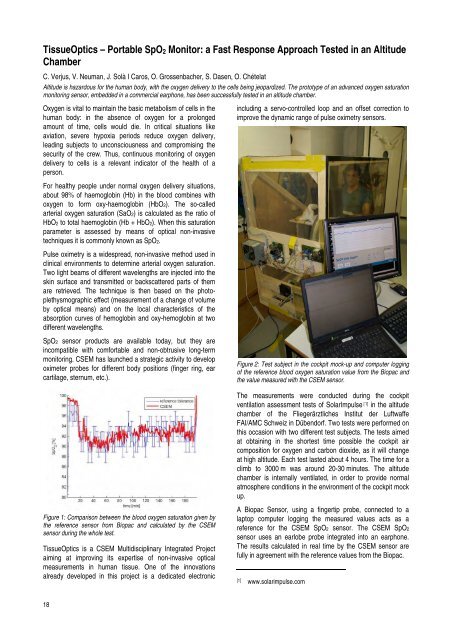research activities in 2007 - CSEM
research activities in 2007 - CSEM
research activities in 2007 - CSEM
You also want an ePaper? Increase the reach of your titles
YUMPU automatically turns print PDFs into web optimized ePapers that Google loves.
TissueOptics – Portable SpO2 Monitor: a Fast Response Approach Tested <strong>in</strong> an Altitude<br />
Chamber<br />
C. Verjus, V. Neuman, J. Solà I Caros, O. Grossenbacher, S. Dasen, O. Chételat<br />
Altitude is hazardous for the human body, with the oxygen delivery to the cells be<strong>in</strong>g jeopardized. The prototype of an advanced oxygen saturation<br />
monitor<strong>in</strong>g sensor, embedded <strong>in</strong> a commercial earphone, has been successfully tested <strong>in</strong> an altitude chamber.<br />
Oxygen is vital to ma<strong>in</strong>ta<strong>in</strong> the basic metabolism of cells <strong>in</strong> the<br />
human body: <strong>in</strong> the absence of oxygen for a prolonged<br />
amount of time, cells would die. In critical situations like<br />
aviation, severe hypoxia periods reduce oxygen delivery,<br />
lead<strong>in</strong>g subjects to unconsciousness and compromis<strong>in</strong>g the<br />
security of the crew. Thus, cont<strong>in</strong>uous monitor<strong>in</strong>g of oxygen<br />
delivery to cells is a relevant <strong>in</strong>dicator of the health of a<br />
person.<br />
For healthy people under normal oxygen delivery situations,<br />
about 98% of haemoglob<strong>in</strong> (Hb) <strong>in</strong> the blood comb<strong>in</strong>es with<br />
oxygen to form oxy-haemoglob<strong>in</strong> (HbO2). The so-called<br />
arterial oxygen saturation (SaO2) is calculated as the ratio of<br />
HbO2 to total haemoglob<strong>in</strong> (Hb + HbO2). When this saturation<br />
parameter is assessed by means of optical non-<strong>in</strong>vasive<br />
techniques it is commonly known as SpO2.<br />
Pulse oximetry is a widespread, non-<strong>in</strong>vasive method used <strong>in</strong><br />
cl<strong>in</strong>ical environments to determ<strong>in</strong>e arterial oxygen saturation.<br />
Two light beams of different wavelengths are <strong>in</strong>jected <strong>in</strong>to the<br />
sk<strong>in</strong> surface and transmitted or backscattered parts of them<br />
are retrieved. The technique is then based on the photoplethysmographic<br />
effect (measurement of a change of volume<br />
by optical means) and on the local characteristics of the<br />
absorption curves of hemoglob<strong>in</strong> and oxy-hemoglob<strong>in</strong> at two<br />
different wavelengths.<br />
SpO2 sensor products are available today, but they are<br />
<strong>in</strong>compatible with comfortable and non-obtrusive long-term<br />
monitor<strong>in</strong>g. <strong>CSEM</strong> has launched a strategic activity to develop<br />
oximeter probes for different body positions (f<strong>in</strong>ger r<strong>in</strong>g, ear<br />
cartilage, sternum, etc.).<br />
Figure 1: Comparison between the blood oxygen saturation given by<br />
the reference sensor from Biopac and calculated by the <strong>CSEM</strong><br />
sensor dur<strong>in</strong>g the whole test.<br />
TissueOptics is a <strong>CSEM</strong> Multidiscipl<strong>in</strong>ary Integrated Project<br />
aim<strong>in</strong>g at improv<strong>in</strong>g its expertise of non-<strong>in</strong>vasive optical<br />
measurements <strong>in</strong> human tissue. One of the <strong>in</strong>novations<br />
already developed <strong>in</strong> this project is a dedicated electronic<br />
18<br />
<strong>in</strong>clud<strong>in</strong>g a servo-controlled loop and an offset correction to<br />
improve the dynamic range of pulse oximetry sensors.<br />
Figure 2: Test subject <strong>in</strong> the cockpit mock-up and computer logg<strong>in</strong>g<br />
of the reference blood oxygen saturation value from the Biopac and<br />
the value measured with the <strong>CSEM</strong> sensor.<br />
The measurements were conducted dur<strong>in</strong>g the cockpit<br />
ventilation assessment tests of SolarImpulse [1] <strong>in</strong> the altitude<br />
chamber of the Fliegerärztliches Institut der Luftwaffe<br />
FAI/AMC Schweiz <strong>in</strong> Dübendorf. Two tests were performed on<br />
this occasion with two different test subjects. The tests aimed<br />
at obta<strong>in</strong><strong>in</strong>g <strong>in</strong> the shortest time possible the cockpit air<br />
composition for oxygen and carbon dioxide, as it will change<br />
at high altitude. Each test lasted about 4 hours. The time for a<br />
climb to 3000 m was around 20-30 m<strong>in</strong>utes. The altitude<br />
chamber is <strong>in</strong>ternally ventilated, <strong>in</strong> order to provide normal<br />
atmosphere conditions <strong>in</strong> the environment of the cockpit mock<br />
up.<br />
A Biopac Sensor, us<strong>in</strong>g a f<strong>in</strong>gertip probe, connected to a<br />
laptop computer logg<strong>in</strong>g the measured values acts as a<br />
reference for the <strong>CSEM</strong> SpO2 sensor. The <strong>CSEM</strong> SpO2<br />
sensor uses an earlobe probe <strong>in</strong>tegrated <strong>in</strong>to an earphone.<br />
The results calculated <strong>in</strong> real time by the <strong>CSEM</strong> sensor are<br />
fully <strong>in</strong> agreement with the reference values from the Biopac.<br />
[1] www.solarimpulse.com








